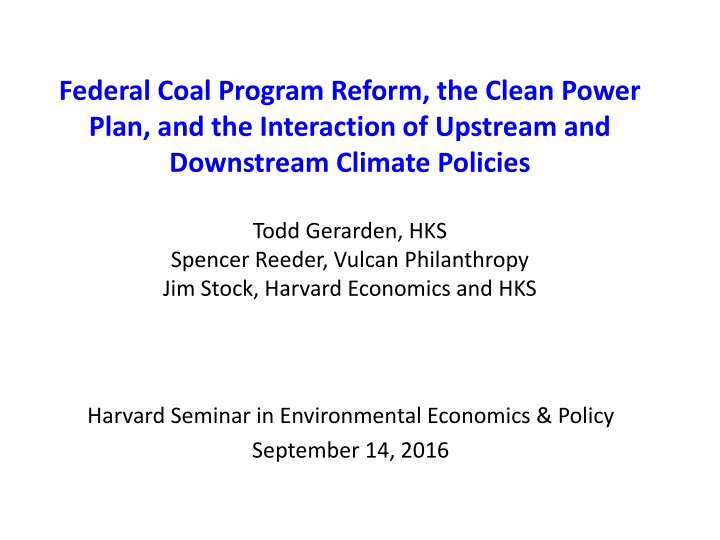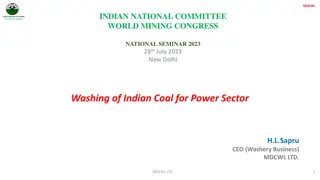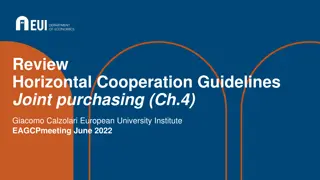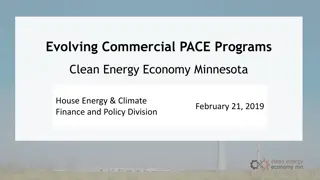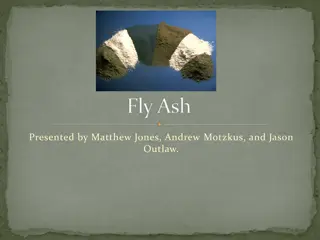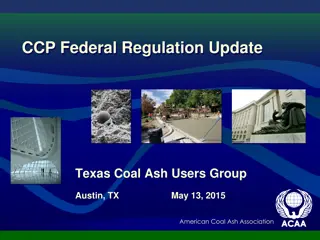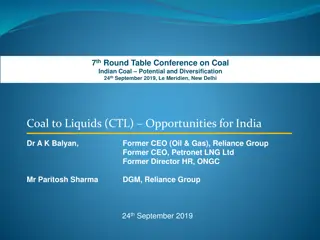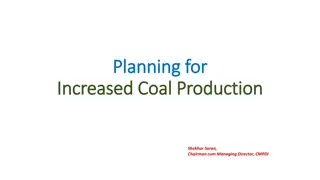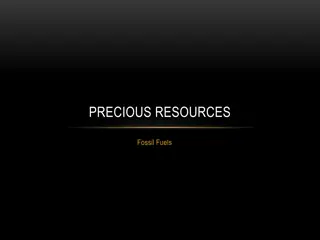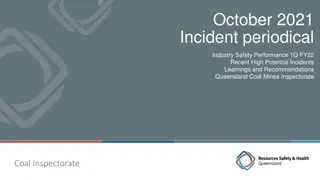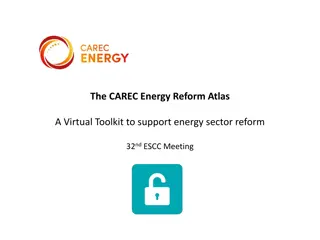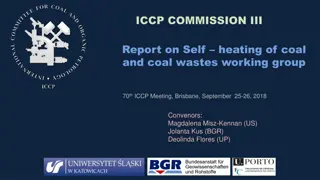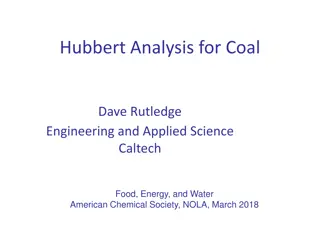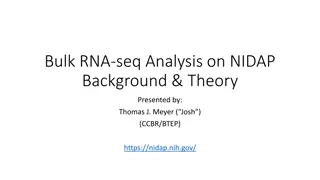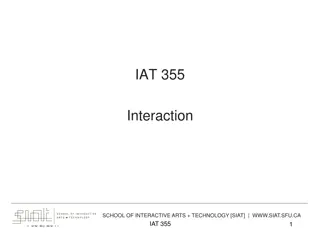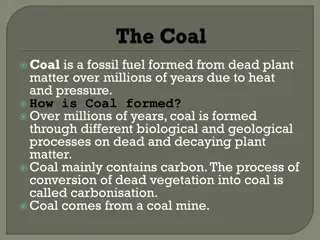Federal Coal Program Reform, the Clean Power Plan, and the Interaction of Upstream and Downstream Climate Policies
The presentation delves into the Federal Coal Program Reform and the Clean Power Plan, examining the interaction of upstream and downstream climate policies. It covers topics such as U.S. coal production, federal coal leasing programs, surface and underground coal mining, and policy recommendations based on research outcomes.
Download Presentation

Please find below an Image/Link to download the presentation.
The content on the website is provided AS IS for your information and personal use only. It may not be sold, licensed, or shared on other websites without obtaining consent from the author.If you encounter any issues during the download, it is possible that the publisher has removed the file from their server.
You are allowed to download the files provided on this website for personal or commercial use, subject to the condition that they are used lawfully. All files are the property of their respective owners.
The content on the website is provided AS IS for your information and personal use only. It may not be sold, licensed, or shared on other websites without obtaining consent from the author.
E N D
Presentation Transcript
Federal Coal Program Reform, the Clean Power Plan, and the Interaction of Upstream and Downstream Climate Policies Todd Gerarden, HKS Spencer Reeder, Vulcan Philanthropy Jim Stock, Harvard Economics and HKS Harvard Seminar in Environmental Economics & Policy September 14, 2016
Upstream, Downstream Downstream The Clean Power Plan Covers power sector National rule, state implementation Mass and rate options Leakage: only generators >25MW covered peakers not covered rate: separate coverage of new and existing additional leakage if mixed mass & rate 1
Upstream, Downstream Upstream Federal Coal Leasing Program 41% of US coal is mined on federal lands 13% of US energy-related GHG emissions 80% of federal coal is surface mined in the Powder River Basin (PRB) PRB coal costs ~1/3 of nonfederal coal per Btu Downstream The Clean Power Plan Covers power sector National rule, state implementation Mass and rate options Leakage: only generators >25MW covered peakers not covered rate: separate coverage of new and existing additional leakage if mixed mass & rate 2
Outline 1. Introduction 2. U.S. coal production, the federal coal program, and the DOI PEIS 3. Comparative statics 4. IPM research design 5. IPM results 6. Policy recommendation and conclusion 3
2. U.S. coal program U.S Coal Basins Source: USGS at http://pubs.usgs.gov/of/1996/of96-092/Comp/main.gif 4
Surface and Underground Coal Mining Drag line, Black Thunder Mine, Arch Coal, PRB Truck that holds 447 tons of coal. North Antelope Rochelle Mine, Peabody Coal, PRB Roof bolter for room and pillar mining Long wall mining in PA 5
Federal coal at a glance Federal coal facts 41% of U.S. coal production 13% of U.S. energy-related CO2 emissions 94% of federal coal is mined in Wyoming, Montana, Colorado, and Utah 80% is surface mining in the PRB Annual Federal and Non-Federal Coal Production (millions of short tons) State Total, 2014 Federal, FY2014 Federal percent Wyoming Montana Colorado Utah Other Total 396 45 24 17 502 983 337 27 17 14 26 421 86% 61% 71% 81% 5% 43% Prompt month coal prices, $/short ton, 7/15/16 Central Appalachia Northern Appalachia Illinois Basin Powder River Basin Uinta Basin 12,500 Btu, 1.2 SO2 13,000 Btu, < 3.0 SO2 11,800 Btu, 5.0 SO2 8,800 Btu, 0.8 SO2 11,700 Btu, 0.8 SO2 $41.10 $43.35 $32.00 $8.70 $39.40 Sources: EIA Annual Coal Report 2015, Sales of Fossil Fuels Produced from Federal and Indian Lands FY2003 through FY 2014. Sources: EIA, SNL 6
Upstream, Downstream Many stakeholders highlighted the tension between producing very large quantities of Federal coal while pursuing policies to reduce US GHG emissions substantially, including from coal combustion DOI PEIS NOI, 81 FR 17724, March 30, 2016 7
DOI Programmatic EIS: Federal Coal Program Jan. 15, 2016: Secretary Jewell announces PEIS process, places moratorium on new leases March 30, 2016: DOI Notice of Intent to Prepare EIS (c) Climate impacts With respect to the climate impacts of the Federal coal program, the Programmatic EIS will examine how best to measure and assess the climate impacts of continued Federal coal production, transportation, and combustion. It will also consider [mitigation by] land use planning, adjustments to the scale and pace of leasing, adjustments to royalties or other means of internalizing externalities, mitigation through greenhouse gas reductions elsewhere, information disclosure, and other approaches. The Programmatic EIS will examine the climate impacts of the coal program in the context of the Nation's climate objectives, as well as the Nation's energy and security needs. FR 81 17725 Sept. 15, 2016: NOI comments due ~Dec., 2016: PEIS scoping document expected 8
Keep it in the ground or not? Climate scientists letter to Secretary Jewell PEIS comment The case for downstream regulation only Substitution of non-Federal coal for Federal coal undercuts keep it in the ground policy The science is clear: to hold global temperature increase well below 2oC, the US must keep the vast majority of its coal in the ground. We urge you to end federal coal leasing, extraction, and burning in order to advance US climate objectives The double counting problem: Upstream regulation is economically inefficient if strong, binding downstream regulation is in place (strong CPP). James Hansen (Columbia) Susan Solomon (MIT) Ken Arrow (Stanford) Mark Jacobson (Stanford) Kerry Emanuel (MIT) Federal extraction communities hit hard if the moratorium becomes permanent 67 total July 27, 2016 9
Policy research questions 1. How do upstream and downstream policies interact in theory? Specific upstream policies: Carbon adder to coal royalties Quantity cap, e.g. permanent moratorium 2. Can we estimate the effects of carbon adder, given various implementations of the CPP taking into account real world complexities Estimates undertaken using the IPM model IPM is the model EPA used for the CPP RIA (for example) 10
Related literature Instrument choice and overlapping policies Holland (2012) Mansur (2012) Goulder and Stavins (2012) Goulder, Jacobsen, and van Benthem (2012) Fischer and Newell (2008) Fischer, Newell, Preonas (2013) Fair value US DOI-IG (2013), US GAO (2014), Haggerty and Haggerty (2015), CEA (2016) Closest to this paper Bushnell, Holland, Hughes, Knittel (2015) Fischer and Preonas (2010) (static model setup) Harstad (2012) (supply side to stem leakage outside international agreement) Hein and Howard (2015) (emissions from coal production) Horowitz and Linn (2015) (technological innovation and rate-based regs) Haggerty, Lawson, and Pearcy (2015) (selected NEMS equations to effect on coal prices of assessing coal royalty on delivered price instead of mine-mouth price) Krupnick et. al. (2015) (legal framework for carbon adder in coal royalty) 11
Comparative Statics of Upstream/Downstream Cases a) No downstream regulation b) Textbook cap-and-trade c) Mass-based cap-and-trade with non-covered sources Strong mass version of CPP has interstate trading but excludes gas CT <25MW + other carve-outs d) Rate regulation with non-covered sources CPP rate-based version (likely FIP) regulates existing fossil sources only New fossil sources are regulated under 111(b) (which doesn t cover small gas CT) 12
Static model: Setup Fuels: federal coal (qFC ), non-federal coal (qNFC ), other covered (qO ) (gas), uncovered (qU) Generation units: MWh produced by burning 1 ton coal Emissions units: tons CO2 produced by burning 1 ton coal = tons CO2 produced by 1MWh of other (other = gas) U = tons CO2 produced by 1MWh of uncovered = ( ) pQ C q rq Representative firm profits: r = federal coal royalty adder i i FC i = + + + E q q q q Emissions: FC NFC O U U = ( ) ( ) W U Q C q E Welfare: i i i Constraints: + + q q q E Mass cap: FC NFC O + + + + ( ) q q q R q q q Rate regulation: FC NFC O FC NFC O Analytics: Take derivatives of firm s first order conditions and social welfare wrt r 13
Comparative statics: (a) only federal coal, no CPP Federal coal only No emissions regulation per-ton coal royalty adder r: Effective marginal cost of generation increases electricity price increases quantity of generation drops S p S p* p0 r D Q0 Q* 14
(b) only Fed coal, mass-based Federal coal only Binding mass-based cap & trade per-ton coal royalty adder r: Price, quantity, and emissions remain the same t+r remains constant (t = allowance price) S p S p* t t r D Q 15
(b) Fed coal & other (gas); mass-based Federal coal & other (gas) , which emits a fraction of what coal emits per MWh Binding mass-based cap & trade per-ton coal royalty adder r: Higher marginal cost of coal induces shift into gas This moves out the MWh associated with the emissions limit So price falls, emissions remain constant, quantity of electricity increases Tradable permit price falls by more than the price If uncovered sources: leakage is reduced (price drops, relative mc of covered generation falls) p S S p* p** t D Q 16
(d) Fed coal & other (gas); rate-based Federal coal & other (gas) , which emits a fraction of what coal emits per MWh Binding rate-based regulation per-ton coal royalty adder r: Coal & gas are used in fixed proportion Royalty adder increases cost of coal-gas bundle Price increases, generation declines, tradeable permit price falls, covered emissions decline Uncovered generation and uncovered emissions increase S p S p* p0 (r share) D Q0 Q* 17
IPM Research Design IPM Proprietary model, ICF International; used by EPA for RIAs, e.g. MATS, CPP Dynamic perfect foresight linear programming model, computes least-cost capacity expansion, electricity dispatch, transmission, subject to existing environmental regulations and reliability constraints makes plant-level generation decisions Endogenously solves for fuel prices Coal component: 36 coal supply regions, 14 coal grades, coal transport network Coal supply curves are developed off-line using mine-level engineering cost curves Key assumptions Aligned to EPA final CPP RIA (IPM v.5.15) Policy frozen Oct. 2015 (no Jan 2016 PTC, ITC extension) Baseline gas prices, renewables prices, demand from AEO2015 Demand is exogenous ( scenarios ); no induced energy efficiency Base cases 1) No CPP 2) Mass-based CPP with regional trading Follows CPP final rule mass-based version with new source complements Covers all fossil units 25 MW 3) Rate-based CPP with regional trading Rate regulation covers existing fossil units 25 MW New sources are covered by 111(b) 18 Full report: http://www.vulcan.com/news/articles/2016/coal-leasing-report
IPM coal supply curves modification Modification for royalty adder The royalty adder schedule is an additional cost per ton by year on federal coal Adders were set at 20%, 50%, 100% of USG SCC (OMB 2013) The mine-level data in the coal supply curve module were updated to include federal/non-federal percentages by mine and cost curve step, WY, MT, CO, UT (only) (LMU concept) The adder was then applied by mine/step/year and regional cost curves were constructed The same adder was imposed regardless of grade and regardless of mining method (surface/underground) The application of the royalty adder to new leases only was modeled by a linear phase-in of the adder (incorporating mine lease history into the coal supply curve module was infeasible) Table 2. Simulated Phased-in Royalty Adders for Federal Coal Indexed to SCC with 10-year linear phase-in (2015$) 20% SCC 50% SCC 100% SCC 2016 2020 2025 2030 $1.53 $8.67 $18.96 $20.98 $3.83 $21.69 $47.41 $52.45 $7.67 $43.37 $94.81 $104.90 Notes: Computed for sub-bituminous coal (heat content 9130 Btu/lb). The SCC is the 2013 USG estimate (OMB 2013). 19
Mineral Rights in the PRB State mineral rights, and some tribal rights, are checkerboarded inholdings Drag line mining follows seams and crosses tracts with different rights ownerships It is not economically feasible to mine only tracts within seams Mines are configured into Logical Mining Units (LMUs); federal royalties are typically paid in proportion to reserves Drag line, Black Thunder Mine, Arch Coal, PRB 20 Source: ONRR; USGS at https://pubs.er.usgs.gov/publication/pp1809
IPM Results: Allowance prices Note: no-adder allowance price in 2030 is $4/$0 (mass/rate) for West, $0/$0 for Northeast 24
IPM Results: State production & royalty revenues Production (left scale) Revenues (right scale) 27
IPM Results: No new or renewed leases Comparison of Upstream Policies under Mass-based CPP Prices and Quantities in 2040 No new upstream policy Carbon royalty adder Tonnage production cap No new leases or renewals 20% SCC 100% SCC 50% cap Emissions (MMT) 1,672 1,653 1,622 1,665 1,631 PRB production (MST) 266 171 20 232 42 Total coal production (MST) 763 730 661 756 678 Wholesale electricity price ($/MWh) $68.67 67.97 $65.08 $68.42 $64.83 Allowance price North Central $29.42 $22.53 $9.03 $27.13 $7.81 South Central $29.68 $22.07 $4.41 $27.39 $5.21 Southeast $31.24 $31.09 $29.67 $30.88 $29.17 Generation (1000 GWh) Solar + Wind 466 433 373 456 393 New NGCC 1,184 1,280 1,472 1,215 1,400 All results are computed under the secondary base case and assuming the mass-based CPP is in place. The tonnage production caps assume a 20 year linear phase-in. Source: IPM simulations by ICF. 28
A Proposal Four Principles 1. Federal fossil fuel leasing policy should take into account the climate externality of burning of those fuels. 2. Avoid double-counting by recognizing interactions with downstream regulation 3. Focus on net climate effects: assess likely substitution 4. Incorporate climate considerations into leasing in a way that supports market efficiency and is consistent with climate policy goals. Specific Proposal: A Carbon Adder to Federal Coal Royalties 1. Incorporate carbon adder into new & renewed federal coal leases, valued at [20%] of Social Cost of Carbon (SCC). 2. Half of royalty receipts directed to affected states (automatic) 3. Half of royalty receipts to fund Federal programs on coal community transitions (requires Congressional action). 29
Why a carbon adder? Why a royalty carbon adder instead of a quantity restriction (permanent moratorium)? 1. Price signal allows market to choose most efficient mines 2. A permanent moratorium double counts the climate externality (outcomes are essentially the same as a 100% SCC adder) 3. Royalty adder generates revenues (~$3B/yr additional) for affected states and Federal coal community transition 4. Administratively straightforward and arguably less complicated than a partial moratorium Can be assessed on tonnage, or on carbon content, at mine mouth Federal coal fraction assessed at level of LMU (current royalty practice) Per-ton adder avoids issues of determining arms-length price 30
Why 20%? 1. The economically optimal rate depends on precise upstream regulation. With (a) upstream regulation with leakage and (b) partial substitution, economically optimal rate is >0 and < 100% 20% is a conservative value, that could move higher if (say) CPP is vacated. 20% puts a floor on CPP 2. 20% SCC aligns coal royalty with oil (30-46% SCC) and gas (16-24% SCC) 3. 20% roughly aligns PRB coal prices with Eastern and Midwestern prices per Btu 4. 20% SCC allows continued production consistent with multiple use mandate 5. 20% SCC royalty adder generates revenues (~$3B/yr additional) for affected states and Federal coal community transition CEA estimates that royalties are maximized at 30% SCC but that excludes reductions in State severance and sales taxes Table 3. Carbon adder schedule for two typical western Federal coals assessed at 20% SCC 2015 dollars per short ton of coal Powder River Basin 8,800 $15.6 $18.3 $20.2 Uinta Basin 11,700 $20.7 $24.3 $26.9 Heat content (Btu/lb) 2018 2025 2030 Notes: based on average CO2 emssions per Btu for US sub-bituminous coal. Source: EIA 31
Effect of 20% Carbon Adder (IPM) Table 2. Estimated Effect of 20% SCC Royalty Adder on Emissions, Production, and Employment CPP Implementation Mass-based Rate-based No CPP 2025 2030 2025 2030 2025 2030 Coal production by basin (million short tons) Powder River Basin Rocky Mountain Central Appalachia Northern Appalachia Illinois Basin All other U.S. Regions -82 -92 -107 -107 -86 -14 -76 -15 0 4 8 1 1 7 -4 2 9 20 -1 2 11 22 19 -53 5 8 1 12 15 10 37 18 18 -33 23 26 -34 16 15 43 9 Total -70 Power sector emissions (million metric tons CO2) -28 -10 -81 -39 -66 -54 Direct mining employment Powder River Basin Rocky Mountain Central Appalachia Northern Appalachia Illinois Basin All other U.S. Regions -1,400 -1,500 100 200 1,100 2,500 3,300 5,700 -1,800 -300 500 1,500 2,200 1,100 3,200 -1,800 -1,400 -1,000 1,200 1,300 1,700 1,900 3,700 -1,300 -1,000 200 1,800 1,600 1,300 2,600 0 0 1,100 1,300 2,000 2,200 5,200 500 1,800 2,400 2,400 5,300 Total Notes: All entries are changes, relative to the no-adder base case, under the indicated CPP implementation. Based on IPM simulations in Vulcan (2016). Direct mining employment is estimated from coal production by basin and average coal productivity by basin. Mass-based CPP is mass-based with new source complements and regional trading. Rate-based CPP is rate-based, with new sources covered by Section 111(b), with regional trading. The royalty adder is phased in to model its application only to the federal component of coal mined in new and renewed leases. For details, see Vulcan (2016) and Gerarden, Reeder, and Stock (2016). 32
Discussion and Conclusions 1. Framework for upstream policies in complex regulatory regime Laid out way to think through combustion externalities for federal fossil fuel leasing Royalty rate should avoid double-counting Details matter Theory, but not numbers, generalize to other federal fossil fuels 2. Depending on CPP implementation, a large royalty adder can have large emissions effects No CPP: 100% SCC produces ~3/4 of the emissions reduction of mass-based CPP Rate CPP: 50% SCC reduces emissions by 95 MMT/yr 3. Main effects of royalty adder (mass-based): allowance price falls wholesale electricity price falls uncovered generation falls (reduced leakage) emissions fall (in large adder cases, CPP ceases to be binding) Eastern coal production and mining employment rises (but self-limiting) revenues are large and increasing up to ~30% SCC adder 4. What have we omitted? Conventional fair return ( good government ) issues Other externalities (e.g., methane emissions) Impact on other state revenues (income tax, severance taxes, ) 33
Coal Rank CO2 emissions per million Btu of energy lb CO2/mmBtu 228.6 205.7 215.4 214.3 210.0 161.3 157.2 139.0 117.0 M mton CO2/mmBtu 0.104 0.093 0.098 0.097 0.095 0.073 0.071 0.063 0.053 Coal (anthracite) Coal (bituminous) Coal (lignite) Coal (subbituminous) Coal (US average) Diesel fuel, #2 h.o., & jet fuel Gasoline Propane Natural gas Source: http://www.eia.gov/tools/faqs/faq.cfm?id=73&t=11 Also see: http://www.eia.gov/coal/production/quarterly/co2_article/co2.html Source: USGS National Coal Assessment Overview 35
Employment Natural Resource Extraction Employment, 1949-2013 Jobs (Thousands) 400 350 Oil and Natural Gas 300 250 200 150 100 Coal 50 0 1945 1955 1965 1975 1985 1995 2005 2015 Source: EIA and BLS. Approximately 90,000 workers were employed at coal mines nationally in 2012. Employment in coal mining is down 1,800 since 2008, and is half of what it was in the early 1980s. Employment in oil and natural gas extraction grew by 133,000 between 2010 to 2013. 36
Recent trends in coal and natural gas markets 37 Source: EIA, Today in Energy, Jan. 8, 2016
Coal production: by region, federal/non-federal 38 Source: EIA, Today in Energy, Jan. 8, 2016
